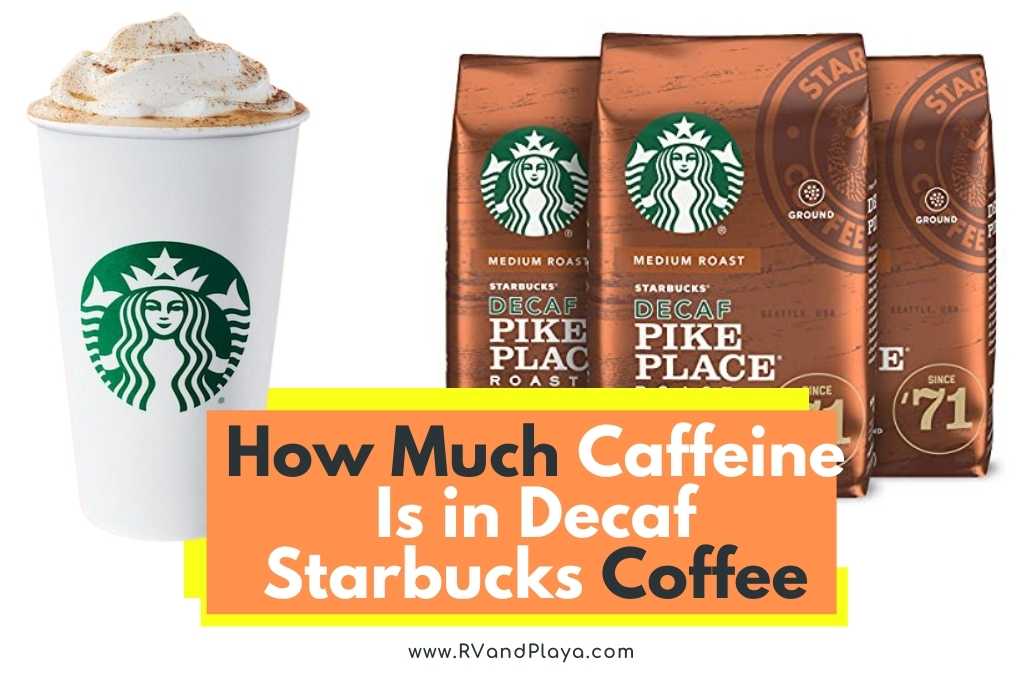Have you ever asked yourself or your friend how much caffeine is in decaf Starbucks coffee? Well, you are at the perfect place to find the answer to such a question.
Let’s look at the caffeine content in Starbucks decaf coffee options. We’ll put things in perspective with other types of coffee.
So, how much caffeine is in decaf Starbucks coffee? On average decaf Starbucks coffee contains around 12 to 13.4 milligrams of caffeine. Decaf coffee is made with beans that once had caffeine in them. They go through the decaffeination process, but traces of caffeine get left behind. I´ve listed below how much caffeine is in decaf Starbucks coffee dependent on the size which included:
• Decaf Starbucks Coffee size Tall (10-12 ounces) contains around 20 milligrams of caffeine.
• Decaf Starbucks Coffee size Grande (14-16 ounces) contains around 25 milligrams of caffeine.
• Decaf Starbucks Coffee size Grande (20-24 ounces) contains around 30 milligrams of caffeine.
We’ll also look at the methods for decaffeinating the coffee beans. Keep reading for a better understanding of what decaf means.
Table of Contents
How Much Caffeine Does a Decaf Starbucks Coffee Contain?
If you tested five different cups of decaf coffee from Starbucks, you may find five different amounts of caffeine in them.
This is especially true if the five cups are brewed from five different batches of decaffeinated beans.
In one study that compared the caffeine in decaf coffees from some well-known brands, Starbucks’ Pike’s Place Roast decaf had more caffeine than any of the others tested.
Starbucks coffee comes in three sizes–tall, grande, and venti. Here’s how each size of the Pike’s Place decaf came out.
- Tall (10-12 ounces) – 20 milligrams
- Grande (14-16 ounces) – 25 milligrams
- Venti (20-24 ounces) – 30 milligrams
McDonald’s large decaf coffee topped out at 18 milligrams of caffeine. It was the closest in caffeine content to Starbucks decaf.
Read also: Which Decaf Coffee Has The Least Caffeine? (Explained)
Why Does Decaf Coffee Have Caffeine in It?
If you’re scratching your head wondering why decaf coffee has caffeine in it, don’t worry, you’re not alone. It’s not common knowledge that there is some caffeine in decaffeinated coffee.
Many people equate decaffeinated with caffeine-free. But the truth is, these aren’t the same thing. So, let’s look at the difference.
Decaffeinated vs. Caffeine-Free
Decaffeinated coffee is made with beans that have been through a decaffeination process. That means the coffee beans contained caffeine to start.
The caffeine was removed from the beans using one of a few available methods. Some coffee beans may still contain trace amounts of caffeine, though.
Caffeine-free coffee is made from beans that never had any caffeine in them. If tested, no caffeine is detected in brewed caffeine-free coffee because there wasn’t any from the beginning.
Read also: Is Kirkland Decaf Coffee Water Processed? (Organic)
How Much Caffeine Is in a Regular Starbucks Coffee?
Now let’s get some perspective. The caffeine content of a regular Pike’s Place Roast cup of coffee is much greater than the decaf version. Here’s a look at those numbers.
- Tall (12 ounces) – 255 milligrams
- Grande (16 ounces) – 310 milligrams
- Venti (20 ounces) – 410 milligrams
What if we compare that to a typical Starbucks latte? These numbers are for lattes ordered as they come.
- Tall (One espresso shot) – 75 milligrams
- Grande (Two espresso shots) – 150 milligrams
- Venti (Two espresso shots) – 150 milligrams
Should you order your latte with extra shots of espresso, you can add 75 milligrams for each extra shot.
How Are Coffee Beans Decaffeinated?
Generally, there are three methods for decaffeinating coffee beans. While some people think the decaffeination process changes the flavor of the coffee, that’s not the case.
The variety of beans you choose, along with the roast type is what determines the flavor.
Here are the decaffeination methods:
- Swiss water method – This is the preferred method for those who like to buy natural products. The process is done through osmosis, meaning the water naturally extracts the caffeine out of the beans. It’s a highly effective method that removes up to 99.9% of the caffeine.
- Solvent-based method – This process relies on a solvent made from water, methylene chloride, and ethyl acetate. The solvent causes the caffeine to dissolve and get released from the beans. The caffeine attaches to the solvent molecules and gets evaporated out.
- Carbon dioxide method – Carbon dioxide is compressed into a liquid. The coffee beans are soaked in the liquid. The highly compressed carbon dioxide pulls the caffeine out of the beans. Then activated carbon filters work to remove the caffeine from the liquid.
The process is repeated until the manufacturer is satisfied that most of the caffeine is gone.
Is Starbucks Decaf Coffee Safe for Those with a Caffeine Sensitivity?
Many people who drink decaf coffee do so because they have health conditions or sensitivities to caffeine. Caffeine can boost your anxiety levels and cause your heart rate to go up.
It’s important to know how much caffeine you’re taking in with your decaf coffee drinks. Let’s say you’re someone who frequently stops for a Grande Decaf Pike’s Place Roast.
One of those has around 25 milligrams of caffeine. That means, in just two of your preferred cups of decaf coffee, you could get 50 milligrams of caffeine.
While 50 milligrams isn’t a lot compared to the 180 milligrams in a normal regular cup of joe, it is still a lot for someone with an extreme sensitivity to caffeine or a heart condition.
Starbucks decaf coffee is safe for most people, but if you are highly sensitive to caffeine, you may want to forgo it.
Conclusion
It might seem weird but almost all decaf coffee has some amount of caffeine in it. Starbucks decaf tends to have a little more caffeine than other brands of decaf.
Remember that decaffeinated and caffeine-free do not mean the same thing.
If you’re sensitive to caffeine, it’s best you skip the decaf and look for a caffeine-free alternative.
Here are some of my favorite services, products, and Stores
There are affiliate links, so if you do decide to use any of them, I´ll earn a small commission. But in all honesty, these are the exact what I use and recommend to everyone, even my own family.
To see all my of most up-to-date recommendations, check out this resource that I made for you!
+ Products & Services
+ Convenience Stores
+ Save Thousands of Dollars
References
https://www.healthline.com/nutrition/caffeine-in-decaf
https://www.caffeineinformer.com/caffeine-content/starbucks-tall-decaf-coffee
Recent Posts
How Much Caffeine Is in Decaf Espresso? (Starbucks, Lavazza, Nespresso, Caffeine-Free)
Have you ever asked yourself how much caffeine is in decaf espresso? Well, you are at the perfect place to find the answer to such a question. Decaf espresso (for example from Starbucks,...
Who Makes Kirkland K Cups (Medium Roast, Pacific Bold, Decaf)
K-Cups have revolutionized the way that we make coffee at home. With the ability to make a single serving of coffee in just a few minutes and choose from your favorite flavors, there is a lot to...


